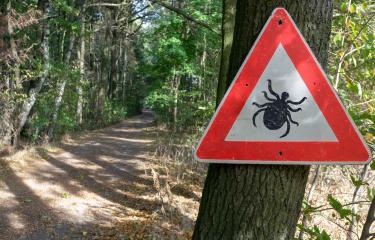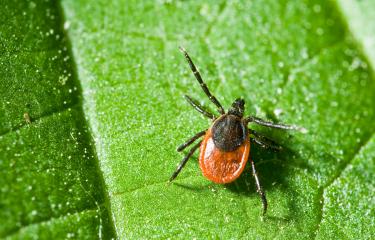What are the causes?
Lyme disease is transmitted by ticks, hematophagous (blood-feeding) arthropods belonging to the order Ixodida (family Ixodidae). The causative agent of Lyme disease was first isolated in a tick of the genus Ixodes in 1982 by Willy Burgdorfer, after whom the agent, Borrelia burgdorferi, is named. It is a gram-negative bacterium (genus Borrelia, family Spirochaetaceae). Many other Borrelia species may be transmitted by ticks.
How do the bacteria spread?
In Europe, Borrelia burgdorferi bacteria are mainly transmitted by the tick species Ixodes ricinus, which is widespread throughout the continent except for the Mediterranean basin and high-altitude regions. This hard tick inhabits various types of environment (forests, wooded pastures and gardens) offering microclimatic conditions compatible with its survival and conducive to its hosts. The life cycle of the Ixodes tick comprises three developmental phases:
- The first two phases (larva and nymph) are asexual. During each of these phases, a single blood meal is taken from a vertebrate host, enabling transition to the next phase. In the third developmental phase, which is sexual, females engorge, lay eggs and subsequently die. Hosts cover a broad spectrum including birds, rodents and deer. Disease transmission is not considered possible in the larval phase. However, larvae can potentially acquire the bacterium during their first blood meal from a reservoir host (rodents and birds).
- During the second blood meal, which enables transition from the nymph phase to adulthood, bacteria already present in the nymph’s digestive system pass through the intestinal barrier, reach the salivary glands and are transmitted to hosts whose blood the ticks are feeding on. Nymphs present a high risk of bacterial transmission if infected as they are small and therefore go unnoticed on the skin, where they can be mistaken for moles.
Lyme disease cannot be transmitted from person to person.
What are the symptoms?
The disease progresses in three stages: the early localized, early disseminated and late disseminated stages.
The early localized stage is characterized by a rapidly expanding painless red blotch around the bite, measuring at least 5cm at the inoculation site. This is known as erythema migrans, and it is the most common symptom (observed in approximately 80% of cases). If the disease is not treated at this early stage, complications affecting the nervous system, joints, heart or skin may occur in the early disseminated and late disseminated stages of the disease.
Onset of the early disseminated stage occurs several weeks after the skin rash, and clinical presentation varies significantly among patients.
The late disseminated stage marks chronic progression of the disease. This stage is chiefly characterized by symptoms affecting the joints, skin and nervous system.
Although the disease is not fatal, it may leave patients with debilitating sequelae if not treated.
How is Lyme disease diagnosed?
Erythema migrans is a diagnostic marker and no additional laboratory testing is required.
The disease is diagnosed based on a clinical assessment supported by laboratory tests during the early disseminated and late disseminated stages of borreliosis. An ELISA (enzyme-linked immunosorbent assay) is generally prescribed to detect antibodies directed against the bacteria and should be followed by additional tests if positive.
What treatments are available?
The only current means of treating borreliosis is antibiotics, which take effect rapidly if the disease is diagnosed sufficiently early. Antibiotic doses are determined by the patient's age, medical history, allergies and state of health.
There is no vaccine for Lyme disease.
How can Lyme disease be prevented?
The most effective preventive measures are to wear long clothing during outdoor activities, in light colors so that ticks can be spotted easily; to use insect repellent (check for any contraindications); to avoid areas known to have a tick population (wooded areas, tall grasses, etc.); and to check your body carefully for ticks after going for a walk. If you have been bitten it is crucial to remove the tick as quickly as possible using tweezers, as the risk of bacterial infection is greater if the tick remains attached for a long time. The affected area should be monitored closely for a further 4 to 8 weeks.
How many people are affected?
Lyme borreliosis is a disease observed in the northern hemisphere (North America, Europe and Asia).
In Europe, only an approximate estimate of Lyme borreliosis incidence is possible, since reporting of the disease is not compulsory in most countries.
In France, between 2009 and 2021, the estimated number of cases each year varied between 26,146 and 68,530, with a notable upward trend.
Detailed figures for the number of cases of Lyme disease each year can be found on the Santé publique France website. The risk of infection is dependent on geographical area, environmental factors and a rise in outdoor activities. The number of human Lyme borreliosis cases varies over the course of the year, with high levels observed between spring and autumn, correlating with the tick life cycle.
March 2024






